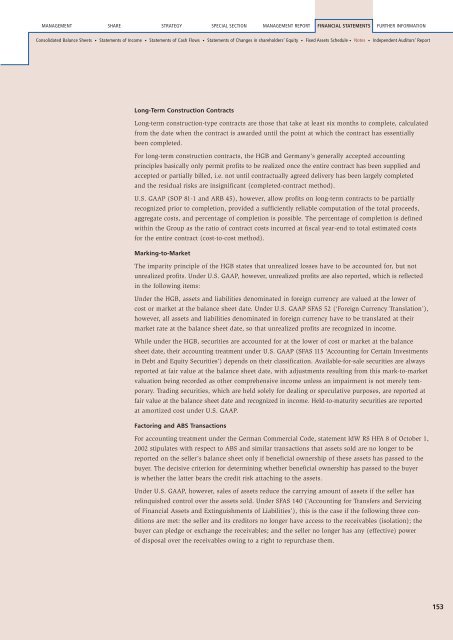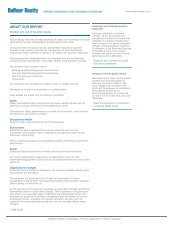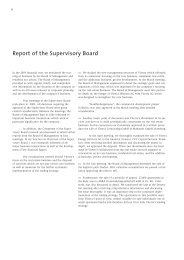E_mg_GB_03_vorne-29_3_04
E_mg_GB_03_vorne-29_3_04
E_mg_GB_03_vorne-29_3_04
Create successful ePaper yourself
Turn your PDF publications into a flip-book with our unique Google optimized e-Paper software.
MANAGEMENT SHARE STRATEGY SPECIAL SECTION MANAGEMENT REPORT FINANCIAL STATEMENTS FURTHER INFORMATION<br />
Consolidated Balance Sheets • Statements of Income • Statements of Cash Flows • Statements of Changes in shareholders’ Equity • Fixed Assets Schedule • Notes • Independent Auditors’ Report<br />
Long-Term Construction Contracts<br />
Long-term construction-type contracts are those that take at least six months to complete, calculated<br />
from the date when the contract is awarded until the point at which the contract has essentially<br />
been completed.<br />
For long-term construction contracts, the H<strong>GB</strong> and Germany’s generally accepted accounting<br />
principles basically only permit profits to be realized once the entire contract has been supplied and<br />
accepted or partially billed, i.e. not until contractually agreed delivery has been largely completed<br />
and the residual risks are insignificant (completed-contract method).<br />
U.S. GAAP (SOP 81-1 and ARB 45), however, allow profits on long-term contracts to be partially<br />
recognized prior to completion, provided a sufficiently reliable computation of the total proceeds,<br />
aggregate costs, and percentage of completion is possible. The percentage of completion is defined<br />
within the Group as the ratio of contract costs incurred at fiscal year-end to total estimated costs<br />
for the entire contract (cost-to-cost method).<br />
Marking-to-Market<br />
The imparity principle of the H<strong>GB</strong> states that unrealized losses have to be accounted for, but not<br />
unrealized profits. Under U.S. GAAP, however, unrealized profits are also reported, which is reflected<br />
in the following items:<br />
Under the H<strong>GB</strong>, assets and liabilities denominated in foreign currency are valued at the lower of<br />
cost or market at the balance sheet date. Under U.S. GAAP SFAS 52 (‘Foreign Currency Translation’),<br />
however, all assets and liabilities denominated in foreign currency have to be translated at their<br />
market rate at the balance sheet date, so that unrealized profits are recognized in income.<br />
While under the H<strong>GB</strong>, securities are accounted for at the lower of cost or market at the balance<br />
sheet date, their accounting treatment under U.S. GAAP (SFAS 115 ‘Accounting for Certain Investments<br />
in Debt and Equity Securities’) depends on their classification. Available-for-sale securities are always<br />
reported at fair value at the balance sheet date, with adjustments resulting from this mark-to-market<br />
valuation being recorded as other comprehensive income unless an impairment is not merely temporary.<br />
Trading securities, which are held solely for dealing or speculative purposes, are reported at<br />
fair value at the balance sheet date and recognized in income. Held-to-maturity securities are reported<br />
at amortized cost under U.S. GAAP.<br />
Factoring and ABS Transactions<br />
For accounting treatment under the German Commercial Code, statement IdW RS HFA 8 of October 1,<br />
2002 stipulates with respect to ABS and similar transactions that assets sold are no longer to be<br />
reported on the seller’s balance sheet only if beneficial ownership of these assets has passed to the<br />
buyer. The decisive criterion for determining whether beneficial ownership has passed to the buyer<br />
is whether the latter bears the credit risk attaching to the assets.<br />
Under U.S. GAAP, however, sales of assets reduce the carrying amount of assets if the seller has<br />
relinquished control over the assets sold. Under SFAS 140 (‘Accounting for Transfers and Servicing<br />
of Financial Assets and Extinguishments of Liabilities’), this is the case if the following three conditions<br />
are met: the seller and its creditors no longer have access to the receivables (isolation); the<br />
buyer can pledge or exchange the receivables; and the seller no longer has any (effective) power<br />
of disposal over the receivables owing to a right to repurchase them.<br />
153









